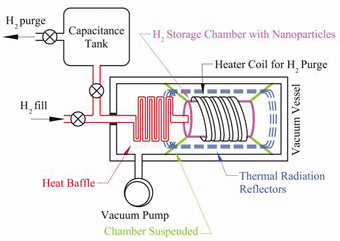|
Low Pressure Cold Pack Fuel Cell Storage |
|
Much of the current research for the replacement of the internal combustion engine is focused on hydrogen fuel cells. Fuel cells use hydrogen and oxygen to create power in an electrochemical process. Before a "hydrogen economy" can be implemented, however, there are several practical problems that must be overcome. For example, despite being the far most abundant element in the universe, hydrogen is surprisingly difficult to produce. Several competing methods must be analyzed to determine how to supply hydrogen to the entire world. The problem we are examining is storage. Hydrogen is a gas at room temperature, but storing it in pressurized cylinders in automobiles could be dangerous. It could also be converted to a liquid form, although that would require extremely low temperatures. Both of these approaches could also be hazardous since hydrogen is very flammable. One of the more promising techniques is storage of hydrogen in metal hydrides. Below is a diagram of our "low pressure cold pack fuel cell storage" system, followed by a summary of our proposal. |
|
|
|
|
|
|
|
Mission Area:
New/Emerging technology and devices - Energy Storage
Operational Capability
Proposed Technical Approach
|
|
Copyright © 2005 Purdue University
Applied Physics Laboratory. All rights reserved. |
